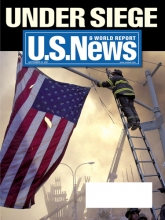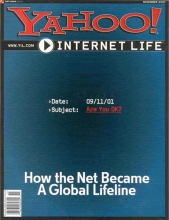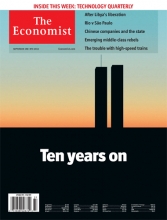 | Newsweek (September 11, 2001) The first covers to hit the stands took a newspaper-like approach with graphic imagery of the explosion of the south tower at the World Trade Center. |
 | TIME (September 14, 2001) This was the first time that TIME decided to use a black border instead of its traditional red. |
 | U.S. News & World Report (September 14, 2001) This cover, like Newsweek's, included a time stamp on its cover: 9:03 a.m. |
 | The Economist (September 22, 2001) |
 | BusinessWeek (September 24, 2001) |
 | The New Republic (September 24, 2001) |
 | New York (September 24, 2001) The image of the skyscrapers proved to be a powerful symbol of loss as well as strength. As many early covers proved, there was little need for traditional cover lines. In the opening pages of this issue, the New York editors wrote: "It was an attack on us. We didn't experience it through the mediation of CNN, but on sidewalks or rooftops or terraces or parks—if we were lucky enough not to be in the midst of it." |
 | The New Yorker (September 24, 2001) The two-toned black cover by Art Spiegelman became an iconic magazine image. The flap for newsstand issues featured bold, red, vertical lettering reading "September 11, 2001." Inside, Roger Angell wrote: "Waking the next morning—was that sleep at any point?—you find the unwanted memory waiting...Waking comes and at first only that, and then the flood of what can't be undone." |
 | Newsweek (September 24, 2001) The photo by Thomas Franklin of the Bergen Record quickly became the iconic image that signaled the transition in the mood of the nation from destruction to conviction. In its "Perspectives" section a few pages later, a volunteer rescue worker is quoted saying, "I never thought I'd see the World Trade Center passing me by in a dump truck." |
 | People (September 24, 2001) This gatefold cover photo was shot by Robert A. Cumins. The airwaves were flooded with video footage, but this still shot served as one of the eeriest images to come out shortly after the attacks—and a reminder of the power and emotion that comes with stopping time. |
 | Sports Illustrated (September 24, 2001) In the magazine, Frank Deford took the stance that games should be played, Rick Reilly wrote about the athletic link to the men on United Flight 93, and Gary Smith wrote about taking his son to a high school football game played the week of 9/11. "It was an odd thing to do—to go to a game—on a day when you walked around wondering why the hell games mattered anymore," Smith wrote. |
 | TIME (September 24, 2001) The weeklies captured the emotional shift as photographers shot the flag at the site of the attacks. |
 | U.S. News & World Report (September 24, 2001) |
 | The Weekly Standard (September 24, 2001) Quickly, attention shifted to what the next step would be in the conflict. |
 | Newsweek (September 27, 2001) |
 | Entertainment Weekly (September 28, 2001) Very soon after the attacks, magazines turned to patriotic imagery. Inside, EW covered reactions from Hollywood and the publishing industries, as well as a behind-the-scenes look at how TV news organizations reacted. "The early hours of the crisis witnessed the rise of another news-gathering source—amateur video," wrote Chris Nashawaty. |
 | Rolling Stone (September 28, 2001) Jann Wenner's flag pin. In this issue, Yoko Ono wrote: "I witnessed Hiroshima, and being in Tokyo when Tokyo was burning. And we survived. We are a very resilient people, the human race...Quite often as we pray for peace, we imagine war. Imagining and prayer have to go together. Imagine all the people living life in peace while you pray." |
 | US Weekly (September 28, 2001) |
 | BusinessWeek (October 1, 2001) Even early on, magazines found that text covers were good solutions to complex questions about what to portray on the cover. |
 | ESPN The Magazine (October 1, 2001) This all-type cover featured a nod to real heroes. The photo that the magazine used on the final page—a close-up of an American flag being stitched onto a Red Sox cap—would also have made for a powerful cover. |
 | The Nation (October 1, 2001) |
 | The New Republic (October 1, 2001) |
 | New York (October 1, 2001) A cover that combines sorrow and pride. The issue features a story called "Braving the Heat" about the city's firefighters. |
 | The New Yorker (October 1, 2001) Within a week, the message to the country—conveyed here—was: Get back to work, but never forget. Illustration by Edward Sorel. |
 | Newsweek (October 1, 2001) |
 | People (October 1, 2001) Collage covers would become more and more popular as a device for anniversary issues, but People took that tack in their second issue after the attacks. |
 | Sports Illustrated (October 1, 2001) The issue featured a timeline of significant moments the American flag has been used in sports. In his back-page column, Rick Reilly wrote: "Let's hope everybody starts pulling for Army, Air Force and Navy. They've got a huge road game coming up." |
 | TIME (October 1, 2001) Focus? Shifted. |
 | The Weekly Standard (October 1, 2001) |
 | U.S. News & World Report (October 1, 2001) |
 | Fortune (October 8, 2001) This is one of the few early covers that used a single person to represent the magnitude of the event. Here an image that connotes terror is paired with cover lines that promise hope. |
 | New York (October 8, 2001) Pride, patriotism, hope—the mood on covers started to change within weeks. Heroic images of Rudy Giuliani became iconic, and we began to see "I Want YOU" cover lines, sometimes in much different contexts (see Maxim, December 2001). |
 | Forbes (October 15, 2001) Some magazines decided against close-ups of the aftermath of the attacks, instead focusing on the Manhattan skyline. |
 | New York (October 29, 2001) In a letter from the editor, Caroline Miller said the magazine got a number of calls and emails after this cover was published. Miller wrote: "I want to make it absolutely clear that the use of this picture was not intended to express anything other than a child working through a traumatic experience. It was drawn an hour after this six-year-old boy...was carried, in his teacher's arms, out of his school." |
 | The New Yorker (October 29, 2001) |
 | The New Yorker (November 5, 2001) |
 | Newsweek (November 5, 2001) Some magazines used patriotic imagery as a design element, sometimes integrating red, white, and blue type in logos or cover-line type. |
 | Newsweek (November 12, 2001) |
 | Esquire (November 2001) Esquire had four days to produce a cover. Design director John Korpics said he tried to create something that suggested a scene without actually showing it. |
 | Fast Company (November 2001) One of the few November issues to use an aggressively upbeat tone in its wording. "A Celebration..." |
 | MAD (November 2001) The flag became the image that many magazines would use to acknowledge the events of 9/11. Most chose to put the flag in upper corners above the logo, while others decided to integrate flag imagery into the typical tone of the magazine. |
 | Men's Journal (November 2001) The firefighter, of course, became a symbol of heroism and patriotism. An equally powerful photo of four firefighters emerging from the site graced the table of contents page, and many more accompanied the feature inside. Cover photo by Matthew McDermott. |
 | My Generation (November-December, 2001) In her editor's letter, Betsy Carter wrote, "In the days after the tragedy, strangers found time to talk with one another—even if it was simply to comment on a cute dog or the pretty color of a sweater. The point was to reach out and connect." Which was exactly what many magazines did with their 9/11 issues. |
 | Stuff (November 2001) In his editor's letter, Greg Gutfeld wrote that everything changed that day—that every joke had a different meaning than it did before. So what was a humor magazine supposed to do? "We acted like Americans and got back to work," he wrote, "entertaining other people and amusing ourselves—while looking closely at partially clad women." |
 | Talk (November 2001) The reason why Rudy Giuliani was a symbol for so many? According to Talk: "As New York City teetered on the brink of despair, its mayor rose to the challenge, keeping the spirit of the city—and the nation—defiantly alive." |
 | Vanity Fair (November 2001) This gatefold and wraparound cover was one of the first monthly magazines to use a portrait shot, rather than a documentary or photojournalistic shot. The 48-page special issue opened with an essay by David Halberstam but was made up primarily of portrait photos—of volunteers, medical teams, survivors and more. Cover photo by Jonas Karlsson. |
 | Yahoo! Internet Life (November 2001) One of the most powerful covers I saw—because it perfectly captured the fear of the unknown felt by so many people, no matter their location. Gail Ghezzi, the design director, said, "We determined "[Are You Okay?]" was a universal response to the event that played out primarily online and specifically in email. In my opinion, the only way to illustrate it was to create a cover that was understated and respectful, knowing that the question itself had great impact." |
 | The New Yorker (December 17, 2001) |
 | Sports Illustrated (December 24, 2011) |
 | |
 | Maxim (December 2001) Flag logos in the corner: Typical treatment for many magazines. Cover lines that combined patriotic overtones with topless women? Much less so. |
 | Newsweek (January 7, 2002) Newsweek sometimes used images as text when representing stories related to 9/11. |
 | American Photo (January/February 2002) Bill Biggart's camera. According to the magazine, he was the only professional photographer killed at the World Trade Center). Inside, the magazine featured stories of 18 photojournalists "who saw the world change." |
 | The Atlantic Monthly (January 2002) |
 | Mother Jones (January 2002) Some chose to go with heavy text covers with simple graphics. Timing and long lead times—and the unpredictability of what cover would resonate months down the line—were likely factors in how and why editors and art directors chose certain approaches. |
 | New York (March 18, 2002) Six months later, the magazine used the same vantage point it did on its first post-9/11 cover. |
 | Newsweek (May 27, 2002) |
 | The Atlantic Monthly (July/August 2002) Features the first in the acclaimed three-part series by William Langewiesche, who spent nine months of "unrivaled access to the disaster site." Langewiesche writes, "For an instant, each tower left an imprint in the air, a phantom of pulverized concrete marking a place that became a memory." Cover photo by Joel Meyerowitz. |
 | The Weekly Standard (September 1, 2002) |
 | The Economist (September 7, 2002) It was common for one-year anniversary issues to feature memorial-type photos—asking readers to remember the structures and everything that day represented. |
 | U.S. News & World Report (September 9, 2002) |
 | Newsweek (September 11, 2002) |
 | TIME (September 11, 2002) In the anniversary issue, TIME reported it had run 21 covers during the year related to 9/11 and its consequences. |
 | BusinessWeek (September 16, 2002) |
 | New York (September 16, 2002) One-year anniversary covers brought emotions full circle—from images of hope and pride to moments of mourning. |
 | The New Yorker (September 16, 2002) Still, some covers decided to use images and colors that represented a more optimistic feeling. Illustration by Ana Juan. |
 | People (September 16, 2002) The feature package, "Stories of Hope," featured widows, rescue crews and a survivor who spent 27 hours in the rubble. |
 | U.S. News & World Report (September 16, 2002) The flag featured was retrieved from Ground Zero. A special note appears on the TOC: "The editors recognize that our flag display is unconventional but believe the image reflects the tragic nature of 9/11." |
 | The Atlantic Monthly (September 2002) The second part of Langewiesche's "Unbuilding the World Trade Center" series. Cover photo by Andrea Booher. |
 | The Atlantic Monthly (October 2002) The final part of the Langewiesche series. Cover photo by Christopher Agou. |
 | TIME (December 18, 2002) |
 | The New Yorker (March 3, 2003) |
 | Esquire (May 2003) Rudy Giuliani—even years later—continued to represent the notion of hope. |
 | New York (September 15, 2003) The issue featured stories of 25 The New Yorkers and how their lives changed. A Daily News photographer buried in rubble. The lawyer representing the flag-raising firemen. A widow who gave birth on October 7, 2001. |
 | The New Yorker (September 15, 2003) Illustration by Gürbüz Doğan Ekşioğlu |
 | Newsweek (September 15, 2003) |
 | New York (May 31, 2004) |
 | The New Yorker (September 13, 2004) Illustration by Istvan Banyai |
 | New York (September 20, 2004) The three-year anniversary issue. |
 | The New Yorker (December 6, 2004) |
 | Popular Mechanics (March 2005) |
 | TIME (May 30, 2005) |
 | New York (August 21, 2006) The five-year anniversary issue. John Hellemann writes: "As a way of marking the fifth anniversary of 9/11, we've attempted to provide an answer—or, rather, many answers. But we've done so in a roundabout manner: by asking an assortment of big thinkers and public figures to address the question, What if 9/11 never happened?" |
 | The New Yorker (September 11, 2006) The five-year anniversary issue with double cover. Illustrations by John Mavroudis and Owen Smith |
 | The New Yorker (September 11, 2006) The five-year anniversary issue with double cover. Illustrations by John Mavroudis and Owen Smith |
 | TIME (September 11, 2006) |
 | Newsweek (September 3, 2007) |
 | Newsweek (August 16, 2010) |
 | The New Yorker (May 16, 2011) |
 | TIME (May 20, 2011) This was TIME's fifth "X" cover. The others: Abu Mousab al-Zarqawi, Saddam Hussein, Japan and Adolf Hitler. |
 | Bloomberg Businessweek (August 8 - August 14, 2011) Ten-year anniversary issues are rolling out now—each providing their own perspectives. Verbally and visually. |
 | The Economist (September 3, 2011) |
 | New York (September 5, 2011) This issue features an A-to-Z "Encyclopedia of 9/11." |
 | The New Yorker (September 12, 2011) Ten years after its two-tone black cover, the magazine returns to similar imagery—but with more light. "Reflections" by Ana Juan. |
 | Newsweek (September 12, 2011) |
 | People (September 12, 2011) The magazine features profiles of children born after their fathers were killed on 9/11. They were photographed by Nigel Parry on Father's Day 2011. |
 | TIME (September 19, 2011) This is only the third time TIME has not used its red border. Artists Julian LaVerdiere and Paul Myoda reimagined their "Tribute in Light" searchlights for how they "may appear like from the heavens," they told TIME. |
 | American Photo (September/October 2011) |
 | CSO (September 2011) |
 | Newsmax (September 2011) |
 | Reader's Digest (September 2011) |






































































































